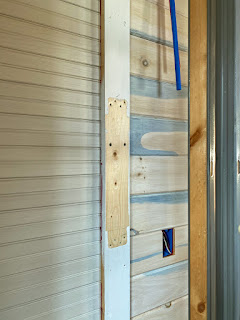The bridge today:
Hiking up to the top of the bridge was much scarier than I anticipated. The breakdown lane is a narrow footpath, the bridge is very high above the water, and traffic zips along at quite a clip. The reward was worth it, though.
Looking north up the Kennebec River:
Looking south:
The Kennebec splits here. In the middle is Swan Island. To the east (left), the water flows south between the island and the town of Dresden.
To the west (right), the water flows south between the island and the town of Richmond.
Swan Island is a gem. It is a 4-mile long, narrow, 1755-acre island that was once its own town (Perkins) and is now the Unorganized Territory of Perkins. Bald eagles have always called the island home. In fact, one of the stories about how the island got its name asserts it was named using the Abenaki word "sowangen" for "island of eagles." After DDT decimated the eagle population, the 1972 DDT ban helped the population recover. Now, the bald eagle population in Maine is growing by 7% a year. There are some bald eagle nesting sites on Swan Island that have been used on and off for decades.
Centuries ago, the four bands of the Kennebec Indians of the Abenaki First Nation--each with their own chief--all paid homage to Chief Kennebis who lived on Little Swan Island, which hugs Swan Island's eastern shore. There was also a Kennebec summer hunting camp on the southern end of Swan Island.
In the 1800s, up to 100 white settlers lived and worked on Swan Island--farming, fishing, logging, shipbuilding, blacksmithing, brick- and glassmaking, and ice harvesting [see link and link]. Over the following decades, the end of ice harvesting, the Great Depression, the decline in prosperity of small farms and, finally, the suspension of ferry service to Swan Island, all contributed to residents moving off the island. The last full-time resident left in the 1960s. In 1988, the island became a wildlife management area; in 1996, the island was added to the National Historic Register. Now people can visit it for the day or to camp overnight. (See this site for more info.)
Prior to this picture-taking stop at the bridge, I had no idea that there used to be a fort at this location. What an interesting discovery! The small park on the Richmond side of the bridge has a number of informational plaques about Fort Richmond.
Before construction began on the new bridge, the Maine Historic Preservation Commission dug some test pits at the site, which revealed remains of the fort. This then led to an archeological dig that lasted from 2012 into 2013. There is a great presentation of some of the archeological finds here and a Facebook page for the dig here. The use of the site changed from one decade to the next, and the structures on the site were torn down and replaced many times over. Therefore, one of the challenges of the dig was figuring out which artifacts belonged to which era.
Fort Richmond was a British fort on the west bank of the Kennebec River, just north of Swan Island. Begun in 1721 as a garrison, by 1723 it was a full fort surrounded by a palisade. When it was rebuilt in 1740, the palisade walls were raised from 86 feet to 96 feet high. When at the height of its activity, the fort had a blockhouse, truck house (trading post), chapel, quarters for officers and soldiers, and ten or more cannons.
Fort Richmond was a British fort on the west bank of the Kennebec River, just north of Swan Island. Begun in 1721 as a garrison, by 1723 it was a full fort surrounded by a palisade. When it was rebuilt in 1740, the palisade walls were raised from 86 feet to 96 feet high. When at the height of its activity, the fort had a blockhouse, truck house (trading post), chapel, quarters for officers and soldiers, and ten or more cannons.
The Abenakis had long been in the area, and a few French settlers had already moved into the area, when the British built the fort. The fort was strategically positioned just beyond the northernmost reach of English settlement at that time in order to facilitate expanding English settlement territory northward.Initially, the site's trading post helped forge trading relationships between natives and settlers. The location on the river--a transportation super-highway back then--made the site more easily accessible as well. Relations between the English settlers and the Abenakis quickly deteriorated. The Abenakis willingly sold large tracts of land to the English but they thought they were granting the English hunting and fishing rights. The English thought they were buying the land itself and could do what they wanted on it and with it. The English also repeatedly violated the terms of treaties they signed with the Abenakis.It would take pages to detail all of the shifts in alliances and all the wars that occurred in this region (between different tribes, the French, and the English) over the decades and centuries. There were raids, attacks, sieges, slaughters, people taken captive--at the fort or within a few miles of the fort.The fort was dismantled in 1755. By then, the English had settled further north and had built three other forts on the Kennebec River: Fort Frankfort in Dresden (later renamed Fort Shirley), Fort Western in Augusta, and Fort Halifax in Winslow. The site became the Parks family homestead from 1776 until 1830. During that period, the fort's cellars were used as garbage pits, which added artifacts to be found during the 2012 archaeological dig.













































